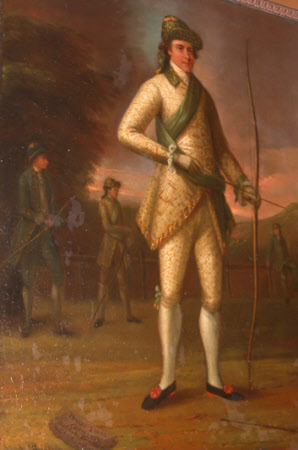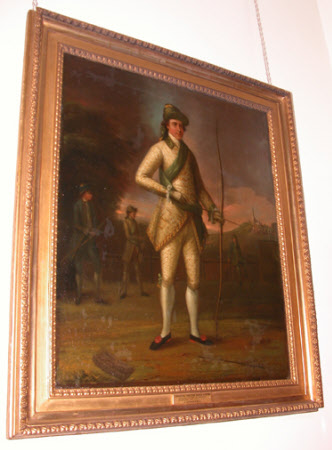Master Middleton (possibly) preparing to Shoot for the Silver Arrow at Harrow (inscribed 5th August, 1758)
Thomas Craskell
Category
Art / Oil paintings
Date
1758
Materials
Oil on canvas
Measurements
749 x 622 mm (29 ½ x 24 ½ in)
Place of origin
England
Order this imageCollection
Anglesey Abbey, Cambridgeshire
NT 515670
Summary
Oil painting on canvas, Master Middleton (possibly) preparing to Shoot for the Silver Arrow at Harrow (inscribed 5th August, 1758) by Thomas Craskell (fl.1748-1758). A full-length portrait of a youth, turned slightly to the right, gazing to the right, dressed in white and gold brocade coat and knee-breeches with blue/green sash, crossed under his right arm and tied on his left hip, white stockings and black shoes with red heels and red rosettes on the front; he also wears a blue/green cap to match the sash. He is holding a long bow in his left hand, the bottom of which rests on the floor, and an arrow in his right hand which he is aligning with the bow. Two other archers are behind him and to the left, each holds a bow, and is gazing to the left. Behind them is a short wall against which a fourth figure is leaning. Distant landscape with trees to the left, and a church on the hill in the right background. Inscribed: Twelve Young / Gentleman / Shoot of the Silver Arrow / August 5 1758 / T. Craskell. At Harrow School a silver arrow was awarded anually as the prize at an archery competition for scholars, which took place on 4 August on the butts at Harrow-on-the-Hill. Names of the winners were reported in the London Chronicle and the Gentleman's Magazine, and in 1758 the former recorded that the silver arrow had been won by a Master Middleton. The wording of its inscription suggests that Craskell's picture may be a portrait of Middleton, a figure about whom little is as yet known. The competitors assembled at the butts, dressed in white and green and sometimes scarlet satin, ornamented with spangles in various 'fanciful devices'. A competitor who planted an arrow within any of the three concentric circles which surrounded the bull's eye was saluted with a merry blast from a band of French hunting-horns, while the archer who shot twelve times in or nearest to the centre became the victor, and bore home the silver arrow to the accompaninment of music and a procession of his schoolfellows. In the evening a ball was held in the spacious schoolroom, attended by all the best families in and around Harrow. The silver arrow was valued at £3 in 1731, and in that year six youths competed for it. The competiton was later extended to twelve scholars, and some time later the date was also changed to the first Thursday in July. In 1765, the competition was attended by a group of Iroquois Indian warriors, who were certain that they could have won the prize had they been allowed to compete. The competiton, founded in 1684, was abolished in 1772, as the event had by then become somewhat 'disorderly'. The only other known paintings of someone wearing a silver arrow archer's costume is that of John Stuart, later 4th Earl and 1st Marquis of Bute (1744-1814) by Alan Ramsay, which is dated 1759 in the Bute Collection, Mount Stuart, Isle of Bute (copy in the Old Speech Room Gallery, Harrow) and that of John Sayer, by Romney, of 1770. The pink silver arrow costume is preserved at Harrow School. Thomas Craskell seems otherwise only to be known as a marine painter, whose The Burning of the Spanish Ship ‘Africa’ off the coast of Havana, and drawing for this, both signed and dated 1748, were/are in the art trade and the National Maritime Museum, respectively.
Provenance
Acquired by Lord Fairhaven (Old Harrovian) by 1959; bequeathed to the National Trust by Huttleston Rogers Broughton, 1st Lord Fairhaven (1896-1966) with the house and the rest of the contents
Credit line
Anglesey Abbey, The Fairhaven Collection (National Trust)
Makers and roles
Thomas Craskell, artist
References
Holdaway 2008: Derek Holdaway, 'On the Butts: Shooting for the Silver Arrow', National Trust Arts Buildings Collections (ABC) Bulletin, Spring 2008, p.9


